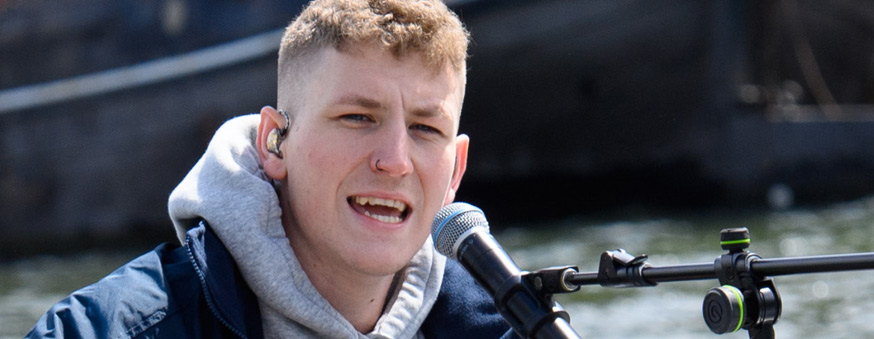
UK Life
Falmouth International Sea Shanty Festival turns 21
For the last 20 years, the Falmouth gathering has pioneered ever-forward with explosive growth and demand…
As the award-winning Falmouth International Sea Shanty Festival announces the programme for its 2025 iteration in Cornwall, the lead organisers, a global music researcher and the director of the Institute of Cornish Studies at the University of Exeter’s Penryn Campus in Cornwall are collectively making a bold statement; they are asserting that sea shanties the most accessible, inclusive and ageless form of performance music ever.
Falmouth International Sea Shanty Festival has provided inspiration for other ports and seafaring locations around the world who have followed their lead as the trend for a shanty writing and performance events grows exponentially.
The annual festival brings sea shanty singers of all ages, genders and ‘ilks’ together for a three-day celebration with over 85 official performances on outside stages, in pubs, in restaurants, in town halls and in and around every street corner. The festival is a ‘runaway success’, and if time and money was no restriction, the festival could easily run for a week or more.
Nicholas Booker, a graduate research associate for the Center for Folklore Studies at The Ohio State University:
“The Falmouth International Sea Shanty Festival demonstrates that there are young audiences around the world who are finding new and vibrant ways to become a part of this musical history that stretches back to the “golden age of sail” two hundred years ago. Shanties have always been participatory and multi-cultural, and we see that tapestry of musical influences on display at the festival in Falmouth.”
Falmouth is a very natural backdrop not just to the event as a historical maritime port, but also as a diverse creative, and lifestyle, destination thanks mainly to the originally arts-focussed Falmouth University, which also runs showcase music, theatre and cultural degrees and has a resultant vibrant student population.
Last year, academic Nicholas Booker, a graduate research associate for the Center for Folklore Studies at The Ohio State University, USA, and a Ph.D. candidate in musicology and ethnomusicology, did his research amidst the Falmouth festival throngs. Nicholas was on a mission to understand more about just how impactful the festival is for folk music in Cornwall and around the world. He was ‘amazed’ with what he experienced.
Having researched several folk and traditional music festivals around the world, Nicholas found that the Falmouth festival demonstrated uniquely enthusiastic engagement among young audiences and included a wide variety of musicians from as far away as North America.
Nicholas Booker:
“The success of, and the evident enthusiasm for, the Falmouth International Sea Shanty Festival demonstrates that shanties and songs of the sea are very much a living tradition. And Falmouth is an excellent place for this sort of festival because of its richly diverse and multi-cultural maritime history, its central place in the vibrant traditions of Cornish singing, and its youthful student population who are carrying this music into the future. Falmouth is a perfect musical crossroads both for honouring the tradition and for developing it for generations to come.”
Today, sea shanty singing is a popular leisure and community pastime, enjoyed amongst laypersons and performed in a variety of contexts, by people of all ages, both along coastlines but also in landlocked towns and cities in the UK, and across the world. The popularity of sea shanty singing can be demonstrated by the global stardom achieved by The Fisherman’s Friends, who achieved a £million record deal with Sony in 2010.
Then the COVID lockdown saw the birth of #ShantyTok when Nathan Evans, a 26-year-old postman and aspiring musician from the non-coastal Dunfermline, outside Glasgow, created a new, modern rendition of a shanty song, thought to have been composed in the late 1830s in New Zealand.
He loaded his catchy version onto TikTok and before he knew it, he was a global ‘shanty sensation’ with more traditional, experienced shanty groups and singers creating their own personal takes on their updated versions of the shanty Nathan had picked: “Wellerman” – a song about an employee of the 19th-century Australian whaling company the Weller Bros.


Nathan Evans
Dr Garry Tregidga:
“Cornish music can come in so many forms. From the area’s rich folk traditions to music from its brass band and chapel culture along with its inspiration to classical composers. Sea shanties are an increasingly vibrant part of its musical identity.”
Dr Garry Tregidga, is a leading member of the Cornish National Music Archive and co-Director of the Institute of Cornish Studies as well as a Senior History lecturer and director of the Institute of Cornish Studies at the University of Exeter’s Penryn Campus in Cornwall, which is also home to Falmouth University.
“Part of the magic of sea shanties is that they’re generally created as a simple, purposefully uncomplex, easily recognisable musical formation with lots of repetition of anyone-can-pick-this-up choruses. Sea shanties were originally songs of sea labour, devised by sailors to accompany certain arduous tasks onboard merchant sailing vessels. They were created to get people, at the time almost exclusively men, grafting together in unison on ships, and to be motivating and uplifting as they did so.
“Much as we have a lot of really talented singers with brilliant voices across our groups, it’s not a musical form that requires optimal ‘tunefulness.’ An absolute belter of a sea shanty is almost like the songs that take off on the football terraces – something recognisable, easy yet deeply meaningful to singers in so many personal ways. I think this is why it’s not too difficult to state that these songs may be the most accessible of any others in the world today.” – Dr Garry Tregidga
It was a set of ‘salty sea dogs’, known as Falmouth Shout, who decided to create the very first Falmouth shanty festival back in 2004. The idea was born in the back room of the legendary Seven Stars pub, and many of those original old boys are still singing in the festival each year, despite a number sadly passing on. One of those founding members Gordon Kelly says, “It was just an idea in the pub one night and we just thought why not – we’ll give it a go, together with the RNLI Falmouth station, to bring groups together, have fun and raise some funds.”
Since entering popular culture, the sea shanty scene has largely been dominated by a male demographic. However, in very recent years, it has evolved to become far more inclusive for different sectors of society, a move very much encouraged by The Falmouth International Sea Shanty Festival.
Over 160 schoolchildren from eight local schools will also be participating and performing in this year’s festival. The groups will take part in a collective parade throughout the town and will perform in at least two different key locations.
This year’s Falmouth International Sea Shanty Festival takes place from Friday 13th to Sunday 15th June 2025, and more than 85 local, national and international sea shanty groups will perform in around 30 venues, in what has easily become the largest free nautical music and song festival in Europe.
More than 50,000 visitors flood into the port each day to see sea shanty groups come together to perform on stages, in cafes, pubs, hotels, and community venues, bringing the history, heritage and culture of maritime song to life in this vibrant Cornish port.
Richard Gates, Festival Chair:
“It is incredible to see the variation of groups that come through year-on-year which is testament to the growing popularity of this tradition. And it’s also so interesting to see the audiences widen in terms of age and demographic. We have everyone from babies in buggies, young families to school and uni students, from our local sailors and dock workers to the oldest people in our community, and everyone in-between experiencing the festival.
“They’re all joining in with the singing at full voice and the atmosphere, the feeling of community is always brilliant no matter what time of day or night it is. It’s great to see, and experience, not just the popularity, but the physical and sensory enjoyment of the good old sea shanty. And great to witness how our festival is driving this historical form of performance and song ever-forward in new, and exciting, contemporary ways.”
For more information on the festival including the detailed schedule, visit the website, www.falmouthseashanty.co.uk.










